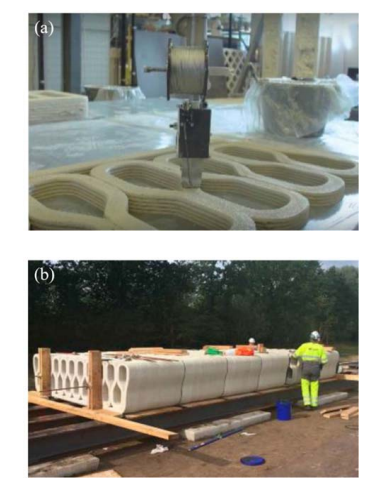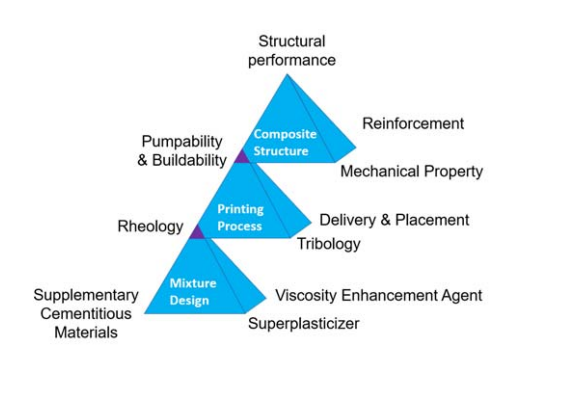Lu Bing recently presented a thesis, ‘Mixture Design and Processing of Novel Spray-based Cementitious Materials for 3D Printing,’ to the School of Civil and Environmental Engineering at the Nanyang Technological University.
With a focus on 3D printing with concrete, Lu Bing notes the ‘remarkable progress’ being made with such materials—promoting more expanded automation in construction, decreasing the need for labor, and improving efficiency over traditional techniques. This is true in many different applications feeling the positive impacts of 3D printing too, from the medical industry to automotive and aerospace. Construction has seen its uses in bridges and a variety of different aspects of infrastructure—not to mention homes.

Printing and assembly of a 3D printed concrete bridge (Salet et al. 2018): (a) printing of the structure unit; (b) onsite assembly of the bridge. Reproduced under Creative Commons Attribution License (http://creativecommons.org/licenses/by/4.0/, no changes were made to the figures)
Work with cement in 3D printing means the need for research and development regarding materials and inks, along with studies including investigation of sand/binder ratio, mixture optimization, and the use of a variety of materials.
“The 3D printing of cementitious materials could be divided into two phases, i.e. delivery and deposition phases (Lu et al. 2019b),” states Bing. “In the delivery phase, the printable cementitious material is delivered through the hose to the printing nozzle with the pressure provided by the pump. In the deposition phase, the printable cementitious material is deposited in a layer-by-layer manner to build the desired structure. The movement of the printing nozzle is usually controlled by gantry or robotic arm.”

Multi-level material design of 3D printable cementitious materials (Lu et al.
2019b). Reproduced with permission © Elsevier

Robotic arm printing system for large-scale 3D cementitious material
printing (Zhang et al. 2018a). Reproduced with permission © Elsevier
3DPCM requires materials with both good pumpability and good buildability in terms of printing. Good pumpability can be delivered in a streamlined manner from the hose to the nozzle, with little chance of clogging. Good buildability leads to large height with very little deformation, meaning that prints are consistent and stable.
During delivery, concrete materials should exhibit low viscosity, and also low dynamic yield stress for pumpability. During printing, the material should offer high static yield stress.
Unstable or inconsistent flow can lead to serious problems like tearing, or varied dimensions in the layers. With inferior pumpability, however, comes a poor structural performance—and with poor buildability, structures may collapse.
Reinforcements must be added either separate from printing or placed simultaneously during fabrication.
Sprayable materials are pumped through a hose and then sprayed onto the substrate after being injected with air. For greater robustness, a wet-mix is usually used, pouring in water at the nozzle during dry-mix.
“… sufficient material adhesion to the substrate in the experiments was guaranteed in this study. However, lack of material adhesion to substrate can lead to the fall of sprayed materials with large thickness, which may affect material distribution. On the other hand, while there is no relevant study on loading mechanism of overhead spray-based printing, it is suspected that the competition between gravity, cohesion between each layer and adhesion to substrate plays an important role in the deposition,” concluded the researcher.
“Substrates made of different materials may also affect the adhesion. In this thesis, timber plates were used as substrates. For more generic applications, other materials such as steel and hardened concrete can be applied in the future study. Tack test can be adopted to assess the adhesion, where thin plates made of substrate materials can be glued to the two parallel testing plates. Alternatively, overhead spray-based 3D printing can be carried out for different substrates with the same mixture. Through comparison of maximum sprayed layers and failure modes, the adhesion between mixture and different substrates can also be assessed.”
What do you think of this news? Let us know your thoughts! Join the discussion of this and other 3D printing topics at 3DPrintBoard.com.
[Source / Images: ‘Mixture Design and Processing of Novel Spray-based Cementitious Materials for 3D Printing’]Subscribe to Our Email Newsletter
Stay up-to-date on all the latest news from the 3D printing industry and receive information and offers from third party vendors.
You May Also Like
Profiling a Construction 3D Printing Pioneer: US Army Corps of Engineers’ Megan Kreiger
The world of construction 3D printing is still so new that the true experts can probably be counted on two hands. Among them is Megan Kreiger, Portfolio Manager of Additive...
US Army Corps of Engineers Taps Lincoln Electric & Eaton for Largest 3D Printed US Civil Works Part
The Soo Locks sit on the US-Canadian border, enabling maritime travel between Lake Superior and Lake Huron, from which ships can reach the rest of the Great Lakes. Crafts carrying...
Construction 3D Printing CEO Reflects on Being Female in Construction
Natalie Wadley, CEO of ChangeMaker3D, could hear the words of her daughter sitting next to her resounding in her head. “Mum, MUM, you’ve won!” Wadley had just won the prestigious...
1Print to Commercialize 3D Printed Coastal Resilience Solutions
1Print, a company that specializes in deploying additive construction (AC) for infrastructure projects, has entered an agreement with the University of Miami (UM) to accelerate commercialization of the SEAHIVE shoreline...






























